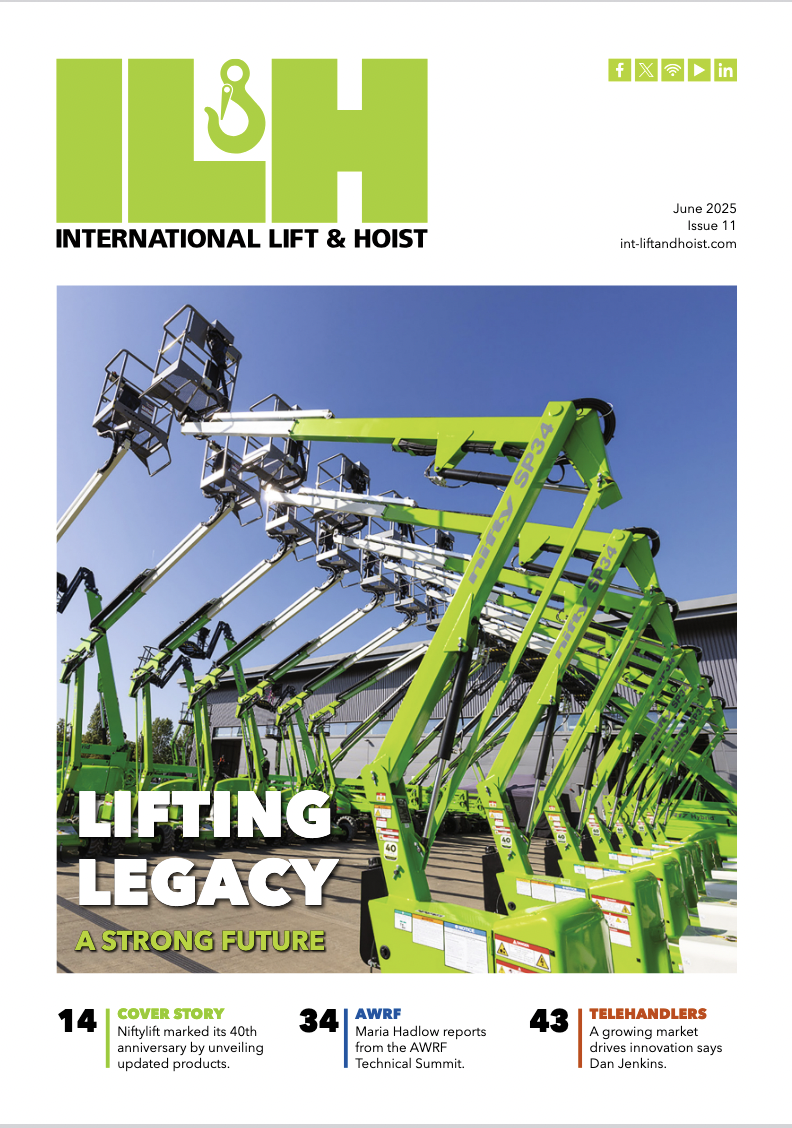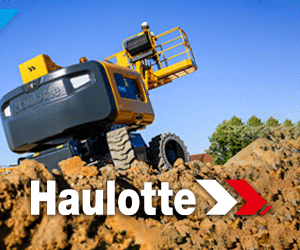Driving a Different Path: Hydrostatic drive makes RTC-80100 easy to transport
Part One
Among rough-terrain cranes, there are many individually unique features but few cranes that stand out as a whole. One exception is Link-Belt's RTC-80100 Series II rough-terrain crane (Image 1), introduced in 2002. The RTC-80100 was conceived from the desire to build an RT crane in the 90- to 100-ton class that was more transportable than other products on the market. Link-Belt Construction Equipment Co., Lexington, Ky., listened closely to its customers. As a result, the RTC-80100 sits a little lower, turns a little tighter, and travels a little smoother than other RT cranes in its class. It also can be quickly and easily configured into a transport weight of less than 90,000 pounds.
The key to achieving these attributes lies in one single deviation from all other RT cranes: the use of a hydrostatic drive system. Conventional cranes utilize the tried-and-true differential drive train, usually with powershift transmission. But the drive system (Image 2) on the RTC-80100 is like no other RT crane.

Hydrostatic drive
Hydrostatic drive is being used with more frequency in the off-road mobile equipment market. In place of drive lines and axle hosing, you will find the extensive housing required to supply six individual wheel motors. The size of this system dictated that Link-Belt turn to alternative sources to assemble a system with these massive requirements. Its search for a supplier led Link-Belt to Linde Hydraulics Corp., Canfield, Ohio. The company was selected for its proven success in underground mining applications, where low-profile equipment works in harsh, demanding environments.
The demand for hydraulic flow in the RTC-80100 is massive. Two large, main-drive variable displacement pumps, also provided by Linde, supply the demand. Each displaces a maximum 88 gpm and operates at 6,000 psi. One pump provides dedicated hydraulic supply to the left wheel motors, while the other powers the right motors. Motors are supplied by SAMPO Hydraulics, based in Finland.
A Linde model DVC 10 microprocessor manages this system and works in conjunction with the engine throttle and the engine control management system. Three drive range modes are available: two-wheel high speed, which produces a maximum 18.5 mph drive speed; two-wheel low speed; and six-wheel drive. The dual drive ranges are achieved by utilizing two two-speed drive motors that displace 384.4 cubic inches per revolution in high speed and 192.2 cubic inches in low speed. Another four single-speed motors displace 192.2 cubic inches, which shift into neutral when in high speed drive. These motors are independently mounted on a suspension with hydraulic dampening.

Precise control
The hydrostatic drive system delivers precise drive control to the operator. For example, a key selling point of the RTC-80100 is its impressive pick-and-carry load chart. When operating over the tandem axles (technically the rear axles), the chart allows a maximum 45-ton capacity. The crane's low profile and center of gravity also contribute to this capability.
Because of the hydrostatic system, the engine can be mounted just about anywhere an engineer desires to place it. In this case, it is mounted in the superstructure, opposite the operator's cab. By placing the engine in the upper, Link-Belt could build a box frame carrier, which according to the company, improves torsional resistance and strengthens the carrier. The result is less flex in the frame, providing improved stability and added operator confidence. Other benefits include reduced height of the carrier. This, combined with using smaller 23.5×25 diameter radial tires, lowers the overall stowed height to 12'2.5".
The innovative 6x6x6 hydrostatic drive/steer system on each wheel delivers a remarkable turning radius • just 21 feet • for a crane with a 26-foot-long carrier. The RTC-80100 offers four steering modes • front only, coordinated six-wheel, six-wheel “crab,” and rear only. Combine these key features with the unit's super smooth hydrostatic drive system, and you have a crane that offers very impressive jobsite maneuverability.

Full-powered boom
A U-shaped, five-section boom uses strategically placed wear pads (Image 3) to disperse the load in order to maximize the overall boom strength and stability. These pads encompass the entire circumference of the formed boom.
The 150-foot main boom operates in three modes. For maximum strength, the A-max (1) system allows for the inner and center sections to be extended to a maximum 95 feet. For maximum stability, the A-max (2) allows the tip, outer, and center sections to be extended to a maximum of 122'6". In standard mode, all sections are telescoped equally.
An optional 31-foot lattice extension allows for an additional second bi-fold section for a total of 51 feet. Deployment of the bi-fold is a one-person operation. There are also optional 15-foot extensions that can take you all the way to 85 feet. All combined, the maximum total tip height is 243 feet and jib offsets are at 2, 25, and 45 degrees; there are no deductions for stowed attachments.
The main winch, supplied by Braden, has up to 21,000 pounds of available line pull and maximum 430 fpm line speed. It is equipped with a two-speed drive motor with automatic brake. Asynchronous, parallel double cross-over grooved drums minimize rope harmonic motion, improve spooling, and rope service life. In addition, deflector rollers are intended to prevent premature rope wear when operating the boom at lower angles. A removable two-speed auxiliary winch is an option.
Next issue, I will share my first-hand impressions of this crane, after a visit to the facility where it is produced and to a jobsite where one owned by MARCO Crane Rental, Phoenix, Ariz., was in use.
Part Two
Among rough-terrain cranes, there are many individually unique features but few cranes that stand out as a whole. One exception is Link-Belt's RTC-80100 Series II rough-terrain crane (Image 1), introduced in 2002. Deviating from the norm, Link-Belt Construction Equipment Co., Lexington, Ky., uses a hydrostatic drive system that is unlike any other RT crane.
Dan Mardian, owner of MARCO Crane Rental, Phoenix, Ariz., owns several of these cranes. Upon his suggestion, I took a closer look at the crane, which included a visit to the facility where it is produced by Link-Belt Construction Equipment Co., Lexington, Ky. Later I visited a jobsite where one of MARCO's RTC-80100's was in use. Finally, I spent time in MARCO's yard where I got a hands-on demonstration of the crane.
![]()
Transportability
Beyond the design benefits gained from using a hydrostatic drive, the real key to transporting this crane is how it can be broken down. With its own winch system and a single part line, this crane can strip itself down from a standard operating weight of 123,666 pounds to a meager 88,300 pounds (Image 2) in less than one hour. Removing the crane's two-part counterweights, weighing 12,000 pounds each, is aided by a control pendant that can be attached to either side of the superstructure. The 8,000-pound outrigger boxes can be removed with an optional patented hook and hydraulically pinned outrigger attachment system. The same pendant control is used for this process as well. It is also necessary to remove any extensions or the auxiliary winch if so equipped. In this configuration, the overall width is also reduced to less than 10 feet.
Once undressed, the RTC-80100 can be loaded onto a conventional 18-inch drop deck trailer. Detached components can be hauled easily on a second truck handled by a second tender truck. Because it is under 10 feet wide and features a low 12'2.5" overall height, the RTC-80100 Series II incurs no daytime or weekend travel restrictions or special permits.

In the cab
Link-Belt pampers it operators. A six-way adjustable fabric seat is very comfortable, the steering wheel tilts providing view to a full array of analog gauges, and dual armrest-mounted joysticks offer full command of the boom from the cab (Image 3). A tilt cab would be a nice addition, however.
All boom controls are pilot pressure controlled. Some consideration was given to an electric-over-hydraulic system, but ultimately, it was decided that the hydrostatic drive was a big enough departure from tradition. Parker pilot controllers are coupled with Husco control valves to provide smooth crane function performance.
Although the dual axles are technically at the rear of the carrier, the steering system is designed to self-correct. Whenever you rotate the upper past 180 degrees, the steering directional input automatically adjusts.
The unit is equipped with a Greer Microguard 434 rated capacity limiter. Link-Belt's Confined Area Lifting Capacity (CALC) system allows for outriggers to be set at three different symmetrical positions. A handheld outrigger control pendant allows the operator to position himself for maximum visibility when extending outriggers.
Although all the cranes I saw were equipped with the Ultra Cab, those being delivered during the first quarter of this year will be equipped with a newly redesigned steel cab recently introduced by Link-Belt. The new cab has a curved upper windshield for improved overhead visibility. Gauges have been re-situated for improved visibility and will now be backlit for improved nighttime operation.

Service issues and accessibility
A six-cylinder, 300-hp Detroit Diesel Series 40 engine produces a generous 1,050 foot-pounds of torque. Thanks to its remote location and ample insulation, I can attest to its super quiet operation. The engine's location and large doors make it easy to service the engine (Image 4).
Link-Belt incorporates its full carrier deck design (Image 5), signified by the Series II tag in the nomenclature. The large deck is generously covered in a non-slip material and access ladders are positioned on all four sides (see image below). The best way to utilize this massive deck is to rotate the superstructure about 35 degrees, allowing a technician to get to the engine and all other service points.
If the superstructure is not in optimum position to allow open access on the deck, Link-Belt's CabWalks are positioned on the sides of the upper to allow technicians access to the engine. CabWalks are made of steel tread plate and are just one of many items incorporated in the design to allow easy servicing.
Other simple, yet telling, examples include trunnion mounts, as shown in Image 6, (rather than bolts) to facilitate the removal of outrigger box cylinders; wiring wrapped in UV- and corrosion-resistant loom material; color and number coded wires and schematics that are universally consistent with other Link-Belt products; and where multiple hydraulic fittings are located together, care has been taken to stagger them for easier wrenching.
It goes without saying that the added hydraulic circuitry of the hydrostatic drive will amplify the potential for hydraulic leaks as compared to a conventional drive train. That's just the nature of the beast. But this seems to be a very reasonable trade considering the unique features and capabilities this crane delivers. In addition, the RTC-80100 occupies a slot in the market where there are few competitive machines. The same can be said for its $822,420 list price.
* Note: Since I did not personally operate this crane, this review does not include my customary likes, dislikes, and verdict.











